
Our Trip
Ahhhh, the Silk Road… Our family thoroughly enjoyed this trip even though going into it, I seemed to be the only one actually excited about our little adventure. Our highlights were definitely the night spent in a tent amongst the sand dunes outside the Gobi Desert and driving 3.5 hours south west of Kashgar to Karakul Lake through the most beautiful mountainous country we've seen since coming to China. We all came home with a bigger understanding of the impact the Silk Road had on China and the world. We also got to delve deeper into the more remote areas of western china eating food we never would have tried and staying in hotels that are only made for sleeping and even that was a stretch.
We traveled the northwestern part of China in the Xinjiang region at the end of September through the beginning of October 2010. This is the best time to go as the weather is perfect (only a light jacket was required in all places we visited) and the sand storm season has not started as it usually happens in the spring. We only had a week but if we'd had longer I would have added a side trip to Turpan. I regret we couldn't see this area. We visited Dunhuang, Urumqi and Kashgar. We spent a lot of time in airports waiting for cancelled flights and dealing with tour guides that thought we needed to be at the airport two hours before take-off. There is a good overnight train that we could have taken but again we were trying to see a lot in only a week and didn't have the time.
Dunhuang
The first day after a 5½ hour flight (one stop in Lanzhou) we arrived in Dunhuang, China. We got off the plane and just breathed in the fresh air and admired the mountains surrounding the airport. Our guide, Robert picked us up at the airport and after a 15-minute ride we arrived at the Silk Road Hotel. This is a very cool hotel located a little outside of town but right on the edge of the sand dunes with a roof top restaurant. We arrived just in time to drop our bags and enjoy dinner and a gorgeous sunset on the roof. The food was only so-so and the service was terrible but the views more than made up for it. They don't offer family rooms so we had two rooms that were clean and just fine for our needs.
After dinner we took off with Robert and saw a really nice Chinese opera that explained how Buddhism started on the Silk Road. Before every scene a screen would come down written in Chinese and English explaining what was happening in the scene. Robert got us in the first row making it somewhat difficult to see the stage, I thought he was crazy putting us so close but he knew exactly what he was doing. During the show we were rained on and felt the heat of fire lighting up the stage. Sean and Sophie loved it and at the same time learned a lot as it was easy for them to understand. I would definitely recommend this show to anyone traveling to Dunhuang.
After the show we visited the night market (small but nice) and ended up buying a silk rug for a fraction of the cost we'd pay in the U.S. You kinda have to buy a silk rug on the Silk Road right? By midnight we were bargained out and ready to head back to the hotel. It was a busy first day but fun.
The next day we started with breakfast on the hotel rooftop, which again, the view was gorgeous and the food only mediocre at best, then Robert picked us up and we drove about 10 minutes to Crescent Moon Lake. Here we spent the morning sand sledding and walking around the dunes admiring this tiny crescent shaped lake in the middle of the vast desert. After that, we asked Robert to take us to his favorite place to eat where we all enjoyed donkey meat made three different ways. Well… I enjoyed the donkey meat; once the kids found out what they were eating they were not so hungry. It's hard for me to understand how we can live in China for 4 years and still our children can't open up their minds to new foods.
After lunch we went back to the hotel for showers and packing for our overnight adventure in the desert. We left the hotel at 4:00 pm with one backpack per person and my camera. We drove about 20 minutes then suddenly the road ended and our 4 camels were waiting to take us to take us to our campground. We boarded the camels that were by the way, super friendly, laid back, clean and very quiet animals. We rode almost 2 hours into the dunes passing a huge graveyard that was just fascinating and by late afternoon we had arrived at our campground. We traveled with our "camel" guide and when we arrived at the campsite, we had a cook, Robert and another guy to help set-up camp. They supplied sleeping bags and the tent and also arranged for a campfire for Sophie (at her request).
By 6:30 the next morning we'd eaten breakfast (scrambled eggs, jam and bread and tea) and were back on the camels again while the sun rose over the dunes. Once again a beautiful site!! We had a 1 ½ hours trip to the famous Mogao Caves where we would view amazing artwork and sculptures explaining how Buddhism started in China via the Silk Road.
We spent about 3 hours in and out of 13 out of over 1,000 caves originally constructed. Each cave we saw was numbered and each with it's own story. My favorite was Cave #46 where a 51-foot reclining Buddha waits to pass to nirvana. He had a peaceful smile on his face and all of his followers were pictured behind him very sad he was leaving their world. Sean and Sophie liked cave #96 where they saw the tallest Buddha statue built in the caves in a 9-story pagoda. He stands at 116 feet tall and has huge hands and feet!
I didn't do much research on these caves before our trip. I was expecting a few hieroglyphics, maybe a few sculptures of different Buddhas but never an entire art gallery carved in caves using extremely vibrant colors and details depicting life as a Buddha. We weren't allowed to take pictures in the caves nor did they have lighting (we all brought flashlights) so for me to describe it wouldn't come close to what we actually saw. I was very disheartened by the various areas of the caves that had been vandalized by other countries. Explorers came and took portions of a masterpiece or scrolls dating back thousand's of years and took them back to their country. Various pieces of these caves can be seen in museums all over the world. For the first time while living in China I was embarrassed to see parts of history stolen by people from my country. I guess that would explain the extremely tight security and precautions that were taken to make sure the caves were properly preserved.
After the caves we went back to the hotel (by van) to get ready for our flight to Urumqi. Frankly, we were done with the camels. They walk way too slow!!
Urumqi
I knew Urumqi wouldn't be the most interesting city so we only scheduled one day here. We checked into the Sheraton in town and basked in our 5 star hotel room and ravaged the western buffet for dinner. The next morning we slept late and had a wonderful brunch, again at the buffet, just what we all needed after spending the night in the desert. After that, I'd planned to walk to the provincial museum and learn about the mummies there. It is supposed to be a really good museum, good enough to schedule a whole day in Urumqi. But, when we arrived, they'd closed the museum for 2 hours. Unfortunately, since this was our only time to go we had to skip the museum. So, we found a mall and walked around a little then found a little teashop and drank lots of tea to kill time before we left for the airport to catch our flight to Kashgar. As it turns out, we ended up spending an additional 4 hours in this airport due to our cancelled flight. Which meant we could have gone to the museum! I would not recommend the Urumqi airport for long layovers, unless of course you enjoy snacking on non-refrigerated pre-packaged camel, yak or horsemeat.
Kashgar
We arrived in Kashgar pretty late that evening. Our guide, Alip, picked us up at the airport and took us to the Huanqiu Jinzuo Hotel where we were to spend three not so glorious nights. We figured it was not going to be fun as it's only a 3-star Chinese hotel and it did not disappoint. We walked in to the cigarette smoke filled lobby and checked in. While finding our rooms we noticed rattraps in the corners of the hallways and our rooms were not close to each other (again no family rooms available) so we split up. This was ok, but the hotel did not even supply water to brush our teeth or drink. I went down to the lobby to inquire and they told me I'd have to go to the store for water. Luckily we had one bottle left from the plane ride that we shared for the night. Once in bed both Sophie and I noticed sand or dirt in the bed. So, we got out brushed off the dirt and I took an Ambien and went to sleep. We tried one more night to have our sheets washed and had the same problem.
Our first morning in Kashgar, we ate our first and last meal at the hotel. I won't go any further on that one, and took off for Abakhoja's tomb, the famous Sunday Animal Market and then just walked around town enjoying everyday street life in Kashgar.
For our last full day in Kashgar we dedicated to Karakul Lake. We took a 3.5-hour, one-way drive southwest to Karakul Lake at 11,000 feet above sea leavel, which overlooks Mount Muztagata. The rugged countryside was both beautiful and intimidating. A small, two-lane road meandered along the riverbed that would be raging and full during the spring melting season, but in early-October only a small stream of water, many rocks and boulders and several herds of camels occupied the riverbed. At times we had to drive off road due to falling rocks blocking our way. This was a little unnerving as we were heading up very high mountain ranges. Along the way many mine shafts were being bored into the mountainsides as part of the beginning of a huge hydroelectric power project being initiated by the Chinese as part of a major development project. Thousands of years of history are about to be changed and brought into modern times. The landscape too will forever change as modernization will erase the actual route used by traders, horses and camels (and now us in our van on the two lane road) know as the Silk Road as it leaves China and enters the middle eastern regions of the world.
Weaving through the mountains and up in elevation, the rugged and snowy mountain tops grew larger as we neared our destination. At this point we were within a few hours from Pakistan and I was surprised to read about so many previous travelers that continued on into the mid east. It was amazing to imagine this wonderful beauty being so far away from western civilization. We even saw sand creeping up over the mountaintops and through the passages being deposited into pristine plateaus. It was very interesting to imagine what was on the other side of the mountain range and the forces of nature it takes to move the tons of sand.
The next morning we took off for Shanghai. All in all we had wonderful time learning about the Silk Road and how important it was to China and the world.
Fun Facts &Tips

Our route from Shanghai to Kashgar.
Dunhuang (our first stop), located in Gansu Province, is a city of only 180,000 people that exists today mainly off of tourism. This is where the Crescent Moon Lake and Mogao Caves are located and the main reason people come to Dunhuang. We traveled in October a good time to visit as the sandstorms are rare at this time of the year.
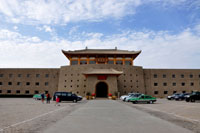
Silk Road Hotel in Dunhuang.
Crescent Moon Lake is a tiny lake surrounded by the Gobi desert located in the city of Dunhuang. It's in the shape of a crescent and this lake as been there for thousands of years. When the natural spring formed it was protected by sand dunes on each side, which with the wind direction, keeps the sand from filling up the lake. It was interesting to see but the excitement for us was the sand sledding. They also offer camel rides and dune surfing all in the same park. We passed on these.
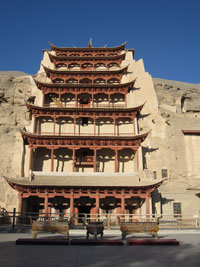
The story of the Mogao Caves or Caves of the Thousand Buddhas, dates back to 366 A.D when a Buddhist monk traveling from India needed a place to meditate. He was very tired and hungry and thought he saw 1,000 golden Buddhas in a cliff. When he got to the cliff, he started sculpting a meditation cell for his devotional contemplation. Once he was done he left the caves and as more monks passed through they added to his work and hence began the movement of bringing Buddhism to China. Many more monks came after him and enhanced each cave with elaborate murals using vibrant colors and huge sculptures and left a library filled with scriptures depicting life as a Buddha. It was during this time that Buddhism and Chinese art combined to create over 1,000 caves filled with teachings of Buddhism. Due to inclement weather, various wars and vandalism, spanning over 17 centuries, only about 600 caves exist today. And, only 30 of these caves are open to the public.
Kashgar (known as Kashi in Chinese), China is the westernmost city in China located near the borders of Afghanistan and Pakistan. Given the current events in the news one can only think of what it may be like to search for Osama Bin Laden in the mountainous regions of the bordering countries. Although extremely rugged terrain dominates the area it is also some of the most beautiful terrain we have ever seen. The rock formations and topography are truly amazing. With about 4 million people in the immediate area, Kashgar is made up of Muslim Uighurs, a growing mix of Han Chinese among others. It is a city rich with over 2000 years of history as being an important stop in the Silk Road.

Currently visiting Kashgar is like going back in time, but soon all this will change. Plans for a new Kashgar are underway and moving at a very fast pace. As only China can do! This article from Newsweek sums up the changes coming to this old very quaint city.
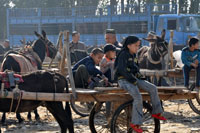
A trip to Kashgar is not complete until you go to the Sunday animal market. It is here where the donkeys, camels and goats way outnumber the taxis. Sure tourists were everywhere but at the same time the locals were conducting business as usual. They seemed not to notice us walking through the mud and snapping pictures left and right.
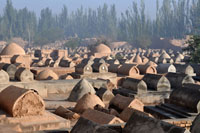
These tombs constructed in 1640 are from five generations (72 tombs in all). The Uyghur's named the tomb after Abak Hoja a very powerful ruler of the 17th century. Some believed him to be a prophet second only to Mohammed. Inside the tiled hall are only about a dozen tombs and outside amongst gardens and trees are the remaining tombs.
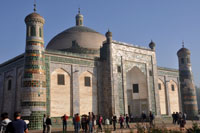
According to the Han (Chinese minority that lives in this region) this place is called the Tomb of the Fragrant Concubine named after Abak Hoja's grandniece that was summoned to act as a concubine for the Qing ruler in Beijing. Uyghur legend says she was so unhappy she committed suicide while the Chinese say she spent 30 years in the emperor's palace then asked to be returned to Kashgar to die with her family. Her tomb, which is located in the same place was excavated in the 1980's and found empty. I wanted to see the tombs mainly because of the great stories behind the Fragrant Concubine.
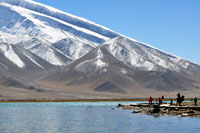
We took the Karakoram Highway, which at one point is only 31 miles from Afganistan and one of the many paths of the Silk Road. Karakul Lake is situated near the junction of the Pamir, Tian Shan and Kunlun mountain ranges and has an elevation of 11,800 feet. The surrounding mountain ranges reach almost 25,000 feet high.
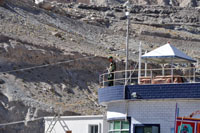
Make sure to take your passports with you to Karakul Lake. On the way we had to stop at a checkpoint show our passports and they recorded our time. Our guide told us we only had a limited amount of time to spend there then we had to go back. If we left too early or too late, we'd be fined. Crazy!! Notice the guy with the gun, I got in trouble later for taking this shot but they didn't take my camera!
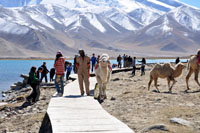
At the lake there are a few yerts you can rent for the night that are common houses for the Tajik ethnic group that live in this area of China. It is super inexpensive to rent one of these but be prepared to share with other people and don't expect in suite shower and bath. They will also cook diner for you. If you stay the night you can see the lake actually change colors throughout the day. It will go from Jade to mauve to golden and then a beautiful dark blue depending on the season and weather. Other activities on the lake include camel rides around the lake and horse rides as well.
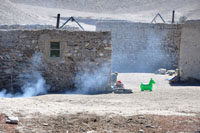
Local village we passed on our way to the lake. We saw lots of these brick houses. Simple and effecient.

If you go Karakul Lake, make sure to have your guide take you through the countryside on your way back to Kashgar. It was just as interesting as everything else we saw. The main mode of transportation out here is motorcyle, tractor and donkey.
Welcome to The Silk Road, China

Our ride to the campsite. You gotta love camping when you have people to carry your stuff, cook your meals and set up your camp.

Crescent Moon Lake. We thought this was going to be a huge deal but actually we had more fun sand sledding then seeing this tiny lake in the middle of the desert. The fascinating part is that it is not man made and it exists in the desert.
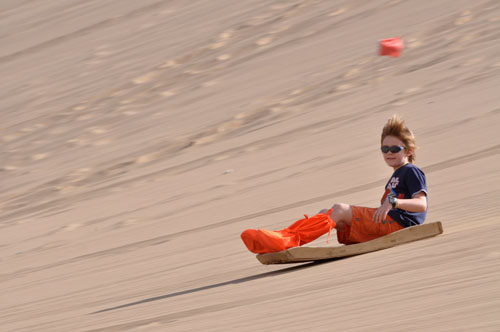
We all loved the sand sledding! It was 10 rmb per ride but that was only because the guy had to carry the heavy wooden sleds up after each run. By the third time, Sean was carrying his own sled up the dune and it was free. He could have done that all day. Sophie and I went together twice with her giving orders on how I should drive the sled the entire time. I still don't know who was driving, her or me. Her poor future husband!!
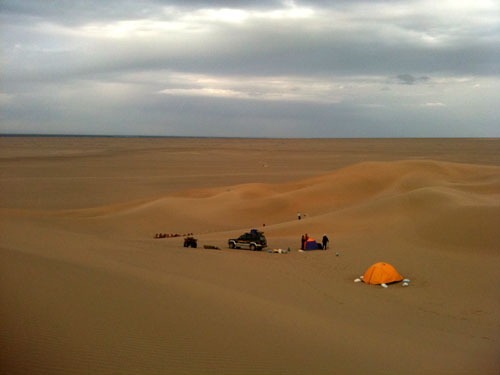
This was our camp-site. Notice no people!! We loved not seeing another sole on this trip. Except of course, our friendly helpers.
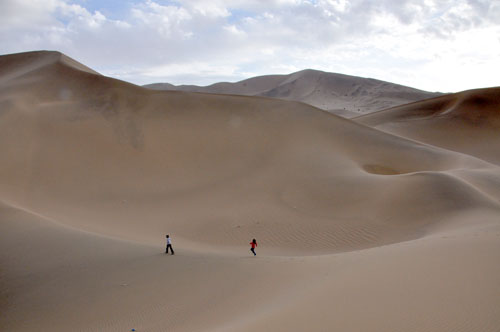
That's Sean and Sophie, once we got off the camels, Sean and Sophie took off for the dunes, digging holes and climbing one dune after another. We didn't see them until dinner and for them this was the highlight of their trip to the Silk Road.

Sophie loved the camels.
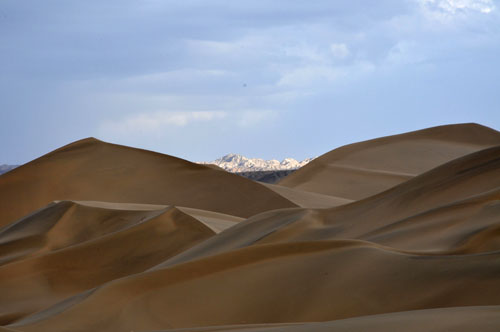
Beautiful!
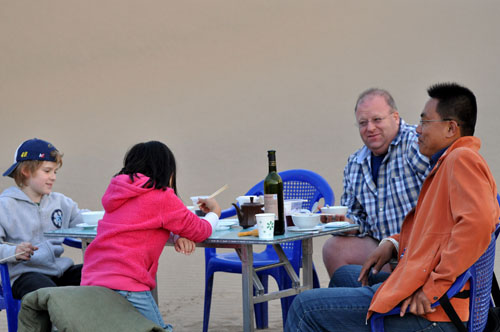
For dinner Robert brought a bottle of wine and lots of beer for the adults. The day before Robert had asked us what kinds of food we liked and the cook surprised us with a wonderful 5-course meal. After dinner the kids played some more than we sat around the campfire until it was time for bed. All four of us slept in one tiny tent set-up by the guides. Outside it was a lot colder than I thought it'd be, but we were all surprised how much heat the tent and our bodies generated that night. We all had a really good time and the kids loved going to the bathroom in the desert. It's so much the little things in life!
The entire time out in the desert, we did not see another person, we never looked at our watches and spent some of the most relaxing time we'd had in ages. It was a great change of pace from our lives in Shanghai.

Our guide for the four day / three night stay in Kashgar was a local Muslim Uighur who was open about telling us the way of Muslim life in the region and how the Chinese are trying to maintain control given the various challenges over the past couple of years. He was straight-forward and no questions were off-limits, which meant that we were able to obtain a wonderful perspective to how locals live and how they see their lives changing as China is keen to develop this area of the Silk Road into a modern day trading and commerce center – a Los Angeles of China, as a comparison.
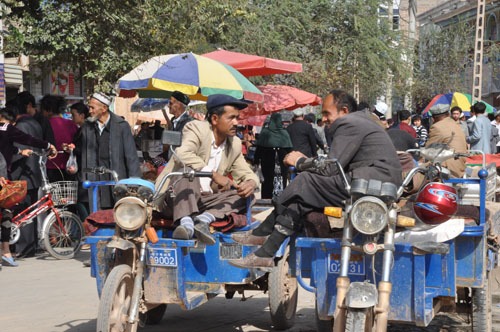
Kashgar - What are they talking about????
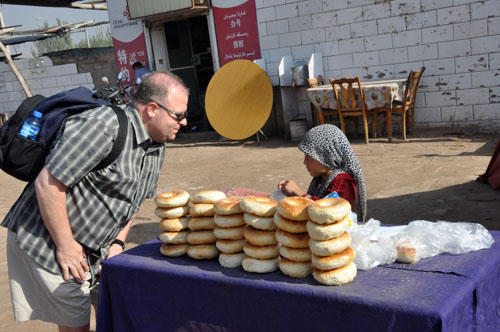
Scott tried forever to get this little girl to crack a smile. No go. She was only interested in the sale. We all ended up loving these bagels this girl was selling. Much better than the U.S. stuff.

I like this picture. It was taken at the Kashgar Sunday market, a huge animal market, and this is how the Uygher's dressed. All of the girls Sophie's age had very short hair. We thought it was interesting as they don't look Chinese at all.
We timed our trip to be in Kashgar for the Sunday market and it was definitely worth it. Being in Kashgar is like going back in time – to a much simpler lifestyle. Every Sunday the locals attend many bazaars throughout the city. Animals (alive and ready to eat), foods, textiles and other staples are traded, bought or sold. Along the way we sampled many of the local fruits and vegetables grown in the region along with a variety of meats (predominantly lamb and mutton). One of the many surprises discovered were the breads and local Naan that are available throughout this market and the rest of the city. A traditional dough with onions and garlic – this Naan is very good and even our finicky children enjoyed it throughout our trip.
After the Sunday market we visited the Kashgar Bazaar and handicraft market, which was so-so. We saw everything here; it was just so big it was a little overwhelming. I enjoyed seeing how different the merchandise was compared to Shanghai and other parts of China we've visited. The goods here come from Saudi Arabia, Pakistan, India, and Turkey among others.
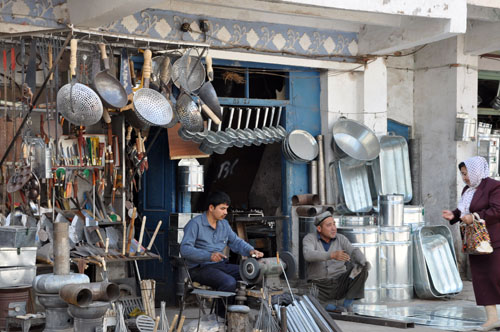
One of my favorite parts of the day was a street Alip (our Kashgar guide) took us to in the old quarter, that had vendors on each side selling goods, tools and food and it was absolutely charming. It was close to here that Kite Runner was filmed. We really enjoyed seeing this part of Kashgar.
One good thing about our hotel was its location. We could walk to just about anywhere. After our day touring Kashgar we walked back to the hotel for some much needed quiet time. The next morning we found John's Café, the best breakfast in Kashgar! Within walking distance of our hotel the coffee was hot and the scrambled eggs excellent. This is a must do if you're dying for a good western breakfast.
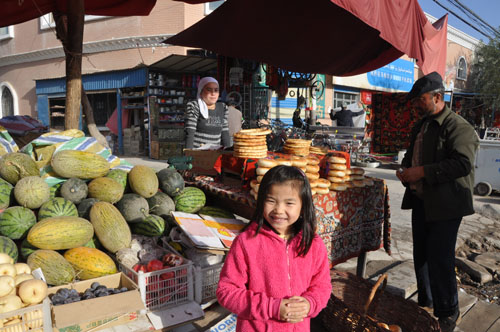
On our last day we drove to Karakul Lake outside of Kashgar and stopped for breakfast on the way. We bought some fruit and naan and we were ready to go.

We saw lots of these Yurts on our way to Karakul Lake, they are home to many people living in the mountains.
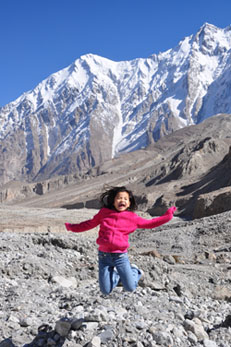
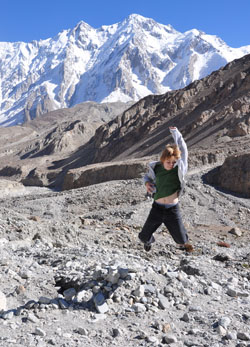
In route to Karakul Lake. Time to release some energy!
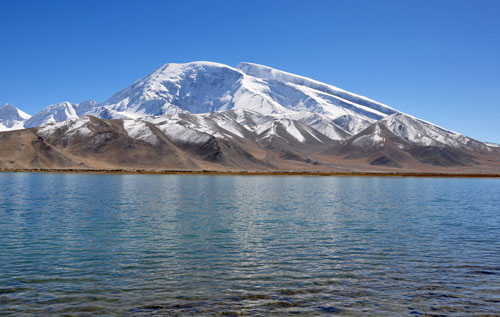
Once we arrived at Karakul Lake, stepped out of the van and into an oasis at 11,000 ft. A beautifully blue lake surrounded by glaciers and snow-covered mountains – this was a sight to behold. The only challenging part of the whole experience was catching your breath. Being so high walking 10 steps seemed like a chore – you could really tell a difference in elevation and we even brought along a tank of oxygen – at the recommendation of our guide – just in case. We walked along one side of the lake and stopped by a few of the peddlers on our way back to the van. In all we spent maybe an hour to 1.5 hours at this wonderful site. Now it was time for the 3.5 hour journey back to Kashgar. It was a long day but totally worth the trip.
